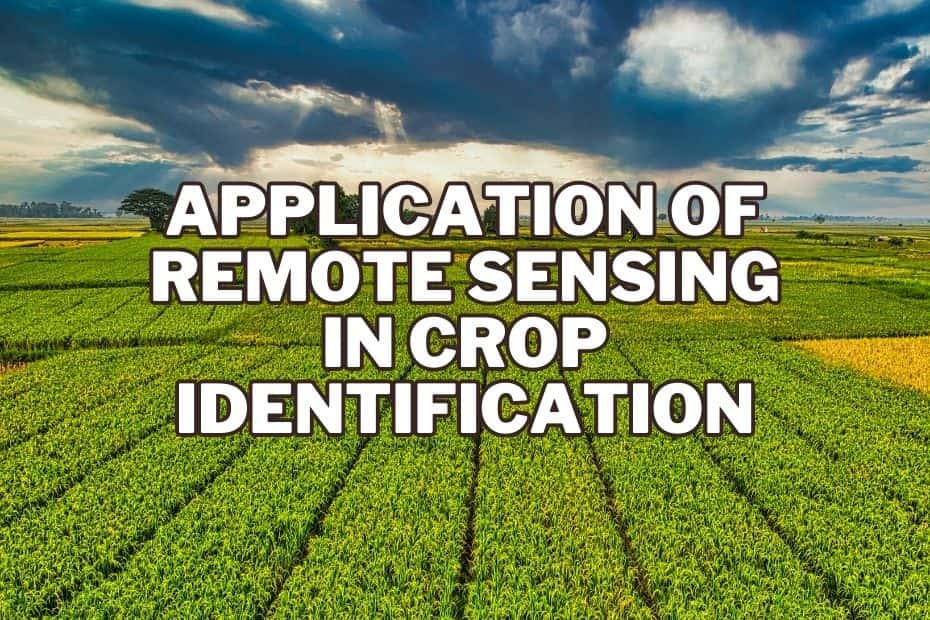Ever imagined identifying crops from thousands of feet in the air with remarkable precision? Welcome to the future of agriculture! The application of remote sensing in crop identification is opening up exciting new frontiers. It’s transforming the way we manage crops and pushing the boundaries of what we once thought possible. Let’s delve into this fascinating world of high-tech agriculture.
The application of remote sensing in crop identification involves the use of satellite or airborne camera images to identify and differentiate various crop types. This technology uses specific wavelengths of the electromagnetic spectrum to detect unique reflective properties of different crops, providing accurate and efficient identification.
8 Application of Remote Sensing in Crop Identification
Remote sensing technology offers valuable insights into the agricultural sector, enabling stakeholders to make informed decisions. Here are the primary applications of this innovative technology in crop identification.
1. Crop Health Assessment
Remote sensing is an invaluable tool for assessing crop health. By analyzing data obtained from satellites or drones, farmers can identify areas of stress in the field. The technology captures images across multiple spectral bands, including visible and near-infrared light. By comparing these images, experts can assess plant vigor and nutritional status, resulting in informed decisions about fertilizer application and other interventions.
- Visible Light (400–700 nm): Healthy plants absorb most of the visible light that falls on them and reflect a large portion of the near-infrared light.
- Near-Infrared Light (700–1100 nm): Stressed or diseased plants reflect more visible light and less near-infrared light.
2. Pest and Disease Detection
Early detection of pests and diseases is crucial in mitigating losses in crop yield. With remote sensing, irregularities in crop growth patterns can be detected, which may indicate the presence of pests or disease. By leveraging multispectral imagery and machine learning algorithms, remote sensing can detect and classify these threats, enabling farmers to take timely action.
3. Soil Moisture Monitoring
Accurate soil moisture information is essential for irrigation planning and drought management. Remote sensing uses microwave radiation to estimate soil moisture content. This information helps in optimizing irrigation, enhancing water usage efficiency, and reducing water wastage.
4. Drought Assessment and Management
Remote sensing plays a pivotal role in drought assessment and management. It enables the measurement of vegetation indices and soil moisture, critical indicators of drought conditions. By providing real-time updates, it aids in early warning and better management of drought situations, ultimately minimizing the impacts on crop yield.
5. Crop Yield Estimation and Prediction
Remote sensing technology can predict crop yield by analyzing vegetation indices, thermal stress, and moisture content. These predictions help in planning and policy-making at various levels, from individual farmers to global commodity markets.
6. Irrigation Management
Efficient irrigation management is critical for crop health and yield. Remote sensing provides spatially distributed information on soil moisture and crop water needs, which can be used to optimize irrigation scheduling, reducing water wastage, and improving crop yield.
7. Crop Growth Stage and Phenology Estimation
Understanding the growth stage and phenology of crops is crucial for efficient farm management. Remote sensing can monitor the phenological stages of crops, providing information on planting dates, maturity stages, and harvesting times. This information allows for better planning and management of agricultural operations.
8. Precision Agriculture and Farm Management
Precision agriculture aims to optimize field-level management with regard to crop health, productivity, and sustainability. Remote sensing provides high-resolution data on a variety of parameters, facilitating precise and site-specific farming practices. It helps in creating field maps, guiding variable rate application of inputs, and monitoring the effectiveness of management practices.
Conclusion
The application of remote sensing in crop identification and management has the potential to revolutionize agriculture, making it more sustainable, efficient, and productive. As technology continues to evolve, the benefits of remote sensing are likely to increase, providing farmers with more accurate data and insights to make informed decisions.
READ MORE: Importance of Remote Sensing in Agriculture
FAQs: Application of Remote Sensing In Crop Identification
How does remote sensing work in agriculture?
Remote sensing in agriculture involves using satellite or drone imagery to monitor and manage crop health and growth. These technologies use different wavelengths of light, including visible and infrared, to capture detailed images of fields. Specific wavelengths can highlight factors like chlorophyll content, leaf water content, and overall plant health, helping farmers make informed decisions about irrigation, fertilization, and pest management.
What is the accuracy of remote sensing in crop identification?
The accuracy of remote sensing in crop identification can be quite high, often exceeding 90% under ideal conditions. However, the accuracy can vary based on several factors including the type of crops, the quality and resolution of the imagery, and the timing of the data collection relative to the crop’s growth stage.
How can remote sensing help in managing crop diseases and pests?
Remote sensing can detect subtle changes in plant health that may be indicative of disease or pest infestations. Different diseases and pests can cause unique spectral responses, which can be detected by remote sensing technologies. Early detection allows farmers to take targeted action, applying treatments only where necessary, reducing costs and minimizing environmental impacts.
What are the limitations of remote sensing in agriculture?
While remote sensing offers many benefits, there are limitations. These include dependence on weather conditions (cloud cover can interfere with data collection), the need for advanced data analysis skills, and the potential for data overload. Additionally, remote sensing provides a broad-scale view and may miss details that can be observed on the ground.
How can remote sensing help in predicting crop yields?
Remote sensing can help predict crop yields by monitoring factors such as plant health, growth stages, and soil moisture levels throughout the growing season. This data, combined with information about weather conditions and farming practices, can be used to model and predict crop yields. Early yield predictions can help farmers and policy makers make informed decisions.
